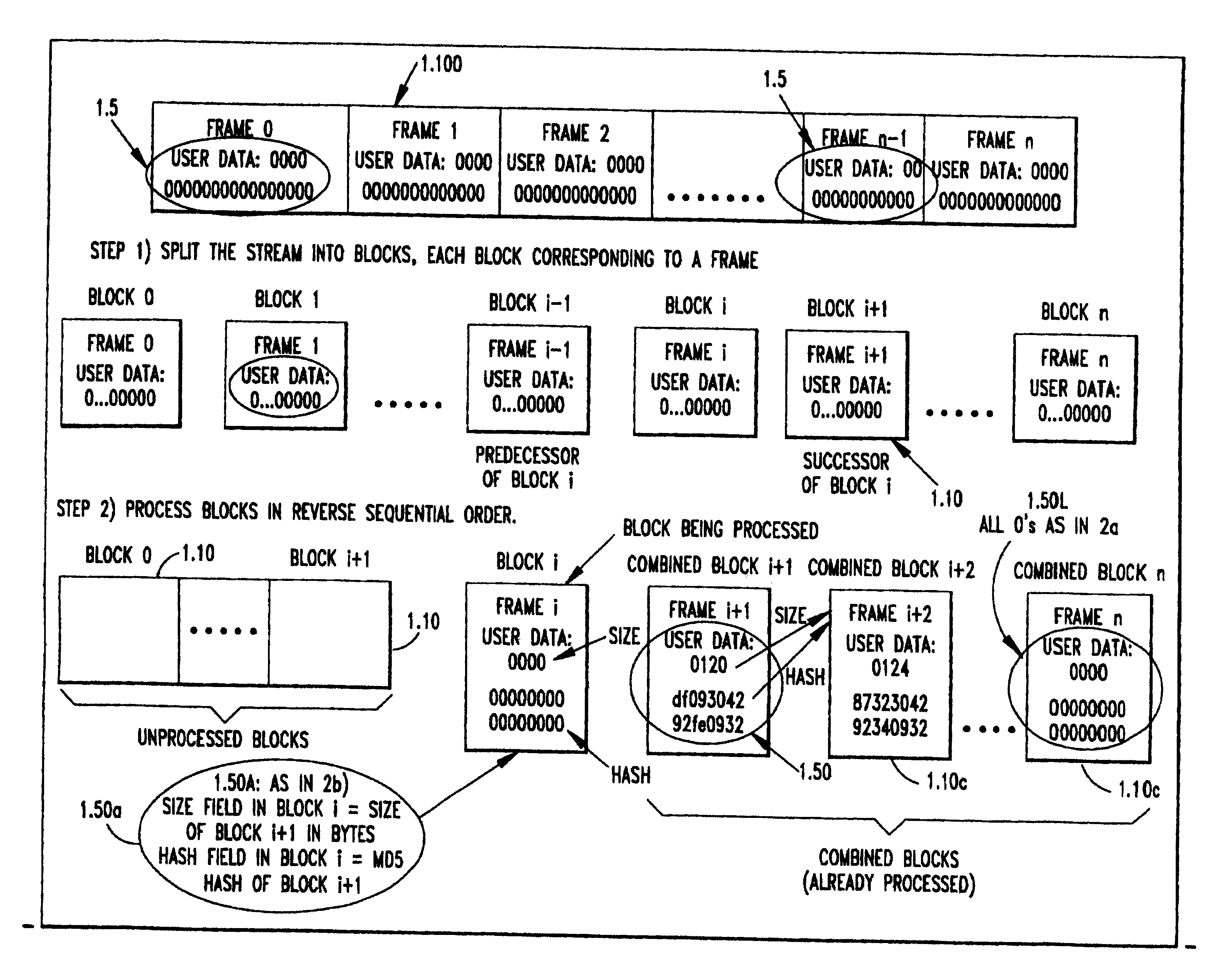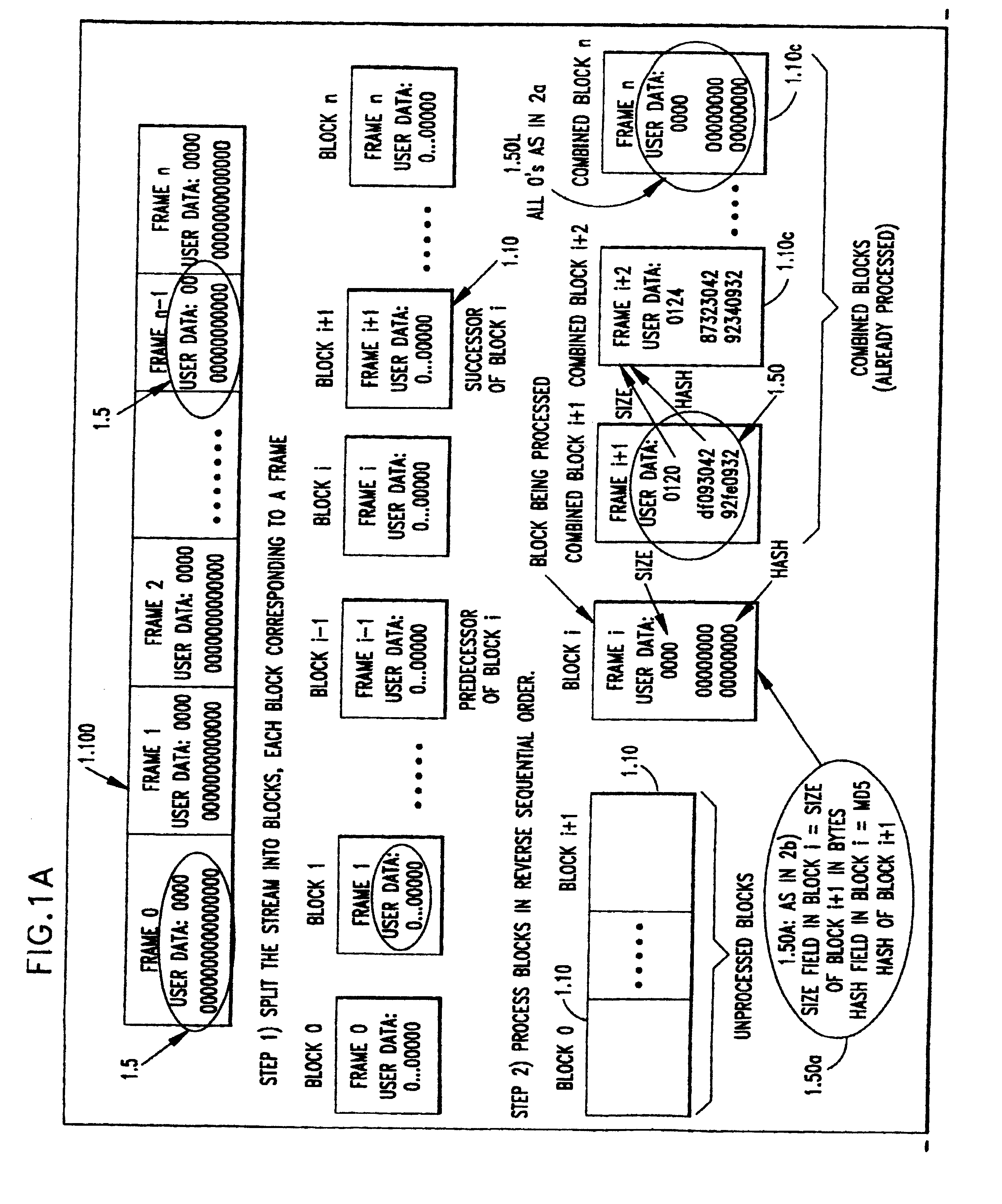How to sign digital streams
a digital stream and stream technology, applied in the field of stream signing, can solve the problems of a potentially very large table on the receiver's end, a bottleneck in the transmission rate of the stream, and high computational cos
- Summary
- Abstract
- Description
- Claims
- Application Information
AI Technical Summary
Benefits of technology
Problems solved by technology
Method used
Image
Examples
embodiment 2
Preferred embodiment for signing streams not known in advance to the sender
(Variant 1)
As in the earlier embodiment for streams known in advance, the preferred embodiment for authenticating streams has been designed to work for MPEG video streams with the USER-DATA section in each frame acting as a placeholder to hold ancillary information. For this variant (Variant 1) refer to FIG. 3.
The original MPEG stream (3.100) is generated with a USER DATA section having a 16+1088=1104 byte placeholder to store ancillary information (3.5). This placeholder is initialized to be all 0's in the original stream. These 1104 bytes are organized as follows: First 16 bytes is the one time public key to be used to authenticate the following block. Next 1088 bytes which are organized as 136 8-byte values are for holding the one time signature on the MD5 hash of the current original block along with the one-time public key field in its user data section.
The specifics of the one-time signature scheme of V...
embodiment 3
Preferred embodiment for signing streams not known in advance to the sender
(Variant 2)
As in the previous embodiment, this embodiment for authenticating streams not known in advance to the sender has been designed to work for MPEG video streams with the USER-DATA section in each frame acting as a placeholder to hold ancillary information. It uses exactly the same hashing, signing and one-time signature scheme as the previous embodiment, the only difference is that in this scheme the one-time signature present in the ancillary portion of a block is for the hash value of the next block (as opposed to the current block). This variant requires a more complex processing strategy for the signer and an easier verification strategy for the receiver.
For Variant 2 refer to FIG. 5, which is described below.
The original MPEG stream (5.100) is generated with a USER DATA section having a 16+4+16+1088=1124 byte placeholder to store ancillary information (5.5), which is initialized to be all 0's in ...
embodiment 4
This embodiment, which is a hybrid of embodiments 1 and embodiment 3, is useful in several situations, an example of which is MPEG audio.
The audio stream is not known to the sender in advance.
Without knowledge of future blocks, the sender must use a scheme like embodiment 2 or 3. Note that this scheme requires more than 1000 bytes of ancillary information per block, and the receiver must have space to buffer at least one block before forwarding it for processing.
The audio stream has its own logical structure consisting of audio frames which allows it to be consumed in very small pieces (say 1000 bytes at a time). The receiver therefore has a buffer of only a few thousand bytes (say 2500 bytes).
The problem that now arises is that in the transmitted bytes only 5% or so could reasonably be allocated for ancillary information. Definitely it is not a good idea to put 1000 bytes of ancillary information into a single audio frame because when these bytes are send, the receiver does not get...
PUM
 Login to View More
Login to View More Abstract
Description
Claims
Application Information
 Login to View More
Login to View More - R&D
- Intellectual Property
- Life Sciences
- Materials
- Tech Scout
- Unparalleled Data Quality
- Higher Quality Content
- 60% Fewer Hallucinations
Browse by: Latest US Patents, China's latest patents, Technical Efficacy Thesaurus, Application Domain, Technology Topic, Popular Technical Reports.
© 2025 PatSnap. All rights reserved.Legal|Privacy policy|Modern Slavery Act Transparency Statement|Sitemap|About US| Contact US: help@patsnap.com



